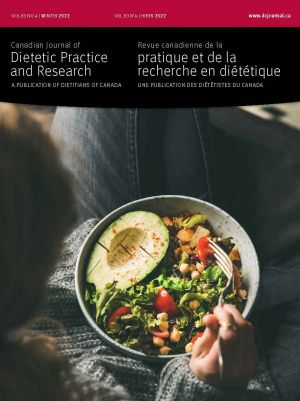Volume 69 • Number 1 • March 2008
Chair’s Message
Editor’s Message
Research
Purpose: New fresh-cut fruit and vegetable products are being developed worldwide. Nutrition educators’ perceptions of these products were studied. Methods: Professional dietitians in Nova Scotia were asked to complete a questionnaire on their use of fresh-cut produce. The questionnaire also elicited their attitudes and perceptions about the convenience, taste/quality, nutrition/health benefits, cost, and safety of fresh-cut fruit and vegetables. Results: Sixty-three percent of respondents reported eating five to six servings of fruit and vegetables a day. This group most frequently consumed fresh-cut fruit as snacks or dessert, and vegetables in stir-fry dishes or salads or cooked with meals. In general, fresh-cut fruit and vegetables were perceived as convenient, safe, and nutritious. While approximately 50% of participants felt fresh-cut produce did not differ in taste from whole fresh produce, almost the same number considered whole fresh produce superior in taste. Conclusions: Dietitians have a generally positive perception of fresh-cut products; however, there is uncertainty about the nutritional value, cost/benefit, and use of the products. Dietitians require more information on the nutrient value of these products and on suggested alternative uses. Attention should be paid to developing fresh-cut products that have good sensory quality.
Review
Recent concerns about adolescent nutrition and unhealthy weights have prompted an examination of the myriad influences on dietary intake during adolescence. Included here are a summary of the literature on family influence on dietary intake, specifically during adolescence and within the family context, a summary of family meal patterns, and a systematic review of the known influences of family meals on dietary intake. Because of the complexity of families in today’s society, models were developed to depict the broad context of familial influences on adolescent nutritional behaviours and attitudes and to describe what is known and not known about family meal influences on adolescent dietary intake and quality. A systematic review of the literature revealed seven articles specifically related to adolescents, family meals, and dietary intake, which were analyzed for strength of evidence and plausibility. In spite of data collection methods relying on self-report, results suggested that family meals were associated with improved dietary intakes. Families in today’s societies are complex. Nevertheless, parents have the potential to influence positively, through family meals, what food is provided, where it is provided (e.g., home, restaurant), and within what type of atmosphere it is provided.
Perspectives in Practice
This innovative, self-directed diet and physical activity program was designed to achieve moderate weight loss in women. Thirty-five overweight or obese hyperlipidemic women completed a 20-week weight loss study. The weight loss intervention consisted of a 20% decrease in energy intake through diet and a 10% increase in energy expenditure through physical activity. The diet consisted of 50-60% carbohydrates, 20% protein, and 20-30% fat. A personal trainer prescribed physical activity regimens. A progress-tracking system and monthly group sessions were used to maintain participant motivation throughout the weight loss period. Participants lost an average of 11.7 ± 2.5 kg (p<0.001). The pattern of weight loss was linear (p<0.001) throughout the study period. Average weight loss per week was 0.59 ± 0.55 kg. This 20-week program, combining a structured self-selected diet and independent preplanned physical activity with motivational strategies, resulted in weight loss comparable to that observed in more controlled interventions. The lower cost, ease of use, and outcome success make this approach potentially useful in a clinical setting.
The Health Canada recommendation of 600 IU of vitamin D daily for those over age 70 may be inadequate to prevent deficiencies. A literature search was conducted to examine whether older people living in long-term care (LTC) facilities are at high risk for vitamin D deficiency and therefore should receive a minimum daily supplement of 800 IU. The search included the major databases; the search terms “elderly” and “vitamin D” were used. Articles primarily related to calcium were excluded. The results show that North American seniors generally consume a diet low in vitamin D and have limited sun exposure. The majority, particularly those living in LTC facilities, may have a vitamin D deficiency. Also contributing to deficiencies is an age-related decline in cutaneous production of vitamin D and altered metabolic processes responsible for converting vitamin D to its active form. In summary, research conducted in both Canada and the United States provides sufficient evidence to indicate that older people living in LTC facilities are at high risk for vitamin D deficiency and should receive a minimum daily supplement of 800 IU.
Traditionally, an emphasis has been placed on dietetic interns’ attainment of entry-level clinical competence in acute care facilities. The perceived risks and benefits of acquiring entry-level clinical competence within long-term and acute care clinical environments were examined. The study included a purposive sample of recent graduates and dietitians (n=14) involved in an integrated internship program. Study subjects participated in in-depth individual interviews. Data were thematically analyzed with the support of data management software QSR N6. Perceived risks and benefits were associated with receiving clinical training exclusively in either environment; risks in one area surfaced as benefits in the other. Themes that emerged included philosophy of care, approach to practice, working environment, depth and breadth of experience, relationships (both client and professional), practice outcomes, employment opportunities, and attitude. Entry-level clinical competence is achievable in both acute and long-term care environments; however, attention must be paid to identified risks. Interns who consider gaining clinical competence exclusively in one area can reduce risks and better position themselves for employment in either practice area by incorporating an affiliation in the other area into their internship program.
Report
Purpose: Parents’ health literacy skills include food and nutrition knowledge, as well as the ability to read, comprehend, and use information related to their children’s health. The evaluation of a nutrition education booklet within the NutriSTEP™ ( Nutri tion S creening T ool for E very P reschooler) Project was conducted. Parents’ nutrition education needs and their sources of nutrition information were also assessed. Methods: Eight dietitians from four provinces conducted in-person interviews with a sample of 322 parents. Parents were asked their perception of the booklet and reported learning. Dietitians’ written feedback on the booklet and their recorded comments and nutrition advice to parents were gathered. Results: Collated feedback led to significant revisions to the booklet. Parents reported increased knowledge from the booklet; 38% wanted more information on nutrition, while 25% wanted to know more about preschoolers and physical activity. The top three sources of nutrition advice for this parent sample were physicians, dietitians, and public health units. Conclusions: Written materials must be evaluated with the target audience to improve readability and comprehension. Further nutrition education efforts should be targeted through parents’ main sources of nutrition information. Further research is needed on nutrition education intervention effectiveness to promote positive health outcomes.










